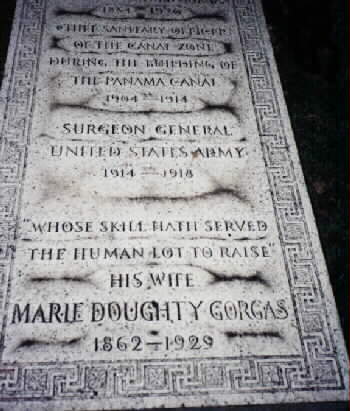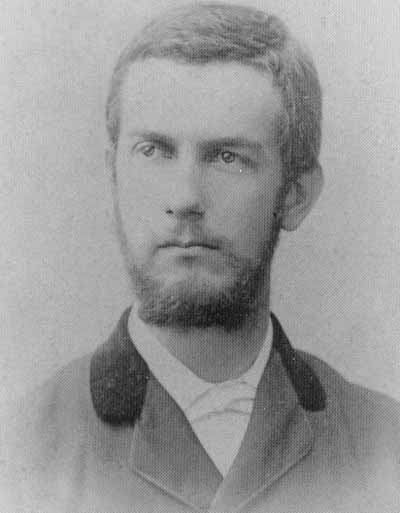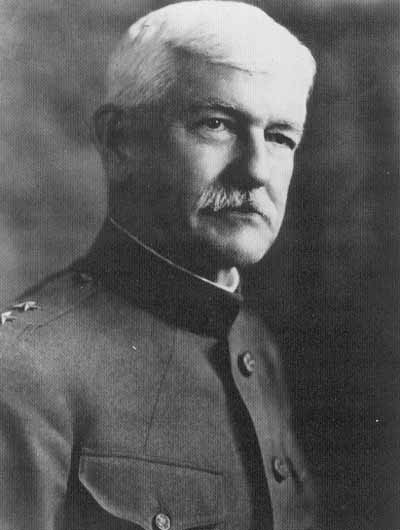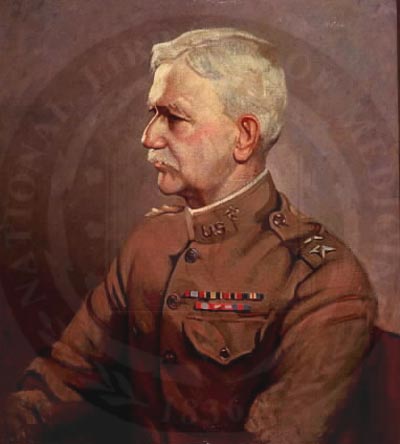Born October 3, 1854, the son of the Confederate Chief of Ordnance during the Civil War, he secured a medical degree from Bellevue Medical College, New York, and then joined the Army Medical Corps.
He traveled from post to post and contracted Yellow Fever at Fort Brown, Texas. Since his recovery from that illness made him immune to its effects, he was sent to Panama where the canal was being built and developed sanitary conditions there which virtually elimiated the disease among the workers.
He became Surgeon General of the Army and retained that position until after World War I, then he retired and devoted himself to the International Health Board.
While on a mission to Europe, he was taken ill in London where he died on July 4, 1920. His funeral was held at St. Paul's Cathedral after which he was returned home for burial in Section 2 of Arlington National Cemetery.
His wife, Marie Doherty Gorgas (1862-1929), is buried with him.
GORGAS, WILLIAM C
MAJ GEN USA RETIRED
VETERAN SERVICE DATES: Unknown
DATE OF DEATH: 07/04/1920
DATE OF INTERMENT: Unknown
BURIED AT: SECTION E SITE 1039S
ARLINGTON NATIONAL CEMETERY
Photo (c) Michael Robert Patterson, 2000
Courtesy of the United States Army
WILLIAM CRAWFORD GORGAS (October 3, 1854-July 3, 1920), Surgeon General, January 16, 1914-October 3, 1918, was the son of General Josiah Gorgas, a native of Pennsylvania who graduated from the United States Military Academy in the class of 1841. Assigned to the ordnance service, he was in command of Mount Vernon Arsenal, near Mobile, Alabama, in 1853, when he married Amelia Gayle, daughter of Judge John Gayle, a former governor of Alabama. William was born at the Gayle home, Toulminville, near Mobile.
The elder Gorgas, strongly sympathetic with the Southern cause, resigned his captain's commission on April 3, 1861, shortly before the attack on Fort Sumter. On April 8 he was appointed a major in the Confederate service and was assigned to duty as chief of ordnance which post he held throughout the war, rising to the grade of brigadier general. In the capital city of the Confederacy, young William spent the four stirring years of the war and with his mother saw the entrance of the Federal troops after his father accompanied General Lee in his evacuation of the city.
Following a short time spent in Baltimore the family moved to Brierfield, Alabama, where the father was manager of the Brierfield Iron Works. In 1869 the University of the South was opened at Sewanee, Tennessee, and General Gorgas was made head of the junior department.
Up to this time the son's education had been quite irregular. He had had the advantages of a private school in Richmond but the times were too distracting for satisfactory progress. He spent six years at the Sewanee school and in 1875 graduated with the degree of bachelor of arts.
From the experiences of his childhood Gorgas had acquired a strong desire for a military career. Every effort was made to obtain for him an appointment to the West Point academy but without avail. Much against his father's wishes he determined to enter the service by way of a medical degree. He entered Bellevue Hospital Medical College in New York in 1876 and was graduated in 1879 after three years of financial difficulties. Following an internship in Bellevue Hospital he was appointed, on June 16, 1880, an assistant surgeon in the medical corps of the army.
For nearly two decades thereafter Gorgas' life was that of the average medical officer of the period. Following several years in Texas posts and a tour of duty in North Dakota he spent practically the entire decade preceding the Spanish-American War at Fort Barrancas in Pensacola Bay, Florida.
Shortly after the beginning of his army career he went through an epidemic of yellow fever at Fort Brown, Texas, and was himself stricken with the disease. Thereafter, as an immune, he was frequently drafted for service where yellow fever existed. This accounts for his long service at Fort Barrancas, a post in a section notorious for its epidemics and itself frequently subject to visitations of the disease. He was promoted to captain June 16, 1885, and to major July 6, 1898. To Gorgas, as to others, yellow fever was an enigma. Its suddenness of appearance, its puzzling choice of victims, and the inutility of ordinary means of disease prevention were quite beyond understanding. With the Spanish-American War in progress, Gorgas arrived at Siboney, in Cuba, on July 7, 1898. While negotiations for the capitulation of Santiago were in progress yellow fever broke out in the American forces. Gorgas was assigned to the yellow fever section of the Siboney hospital and shortly thereafter took over the command of the hospital from Major Louis A. La Garde. It is significant of the view of the disease then currently held that it was recommended that the village of Siboney be destroyed by fire. Not only was this recommendation carried out, but in September the Siboney group of hospitals with much of their equipment was similarly destroyed.
Major Gorgas was returned to the United States in September, convalescent from typhoid fever. Later in 1898 be returned to Cuba and early in 1899 he became chief surgeon of the Department of Havana. Following the appointment of General Leonard Wood as military governor of Cuba in December 1899, Gorgas was made chief sanitary officer for the city of Havana. Though yellow fever at this time showed only as sporadic cases it was, as always, the chief concern. Gorgas applied to the city the generally accepted methods of disease control. He cleaned up the city, segregated the sick, and quarantined infected localities. Though a friend of Dr. Carlos J. Finlay and familiar with his theory of the mosquito transmission of yellow fever Gorgas placed no confidence in the idea. Despite the greatly improved sanitary condition of Havana the yellow fever situation, instead of improving, became much more serious. It was not until the board, of which Major Walter Reed was the head, furnished proof that the Stegomyia mosquito was the carrier of the disease that truly effective methods could be instituted. The Stegomyia, since more accurately named Aëdes Aegypti, was the common mosquito pest of the city. It is a highly domesticated insect, breeding in all kinds of water containers in and around habitations. The surest control of the insect was deemed to be the elimination of its breeding places. This plan was adopted and, though the task had many difficulties, Havana was not only freed of its mosquitoes but was permanently rid of yellow fever. The results obtained by his work in Havana brought him an international reputation as a sanitarian.
The years from 1900 to 1904 brought the gradual development of plans for digging the Panama Canal. There was early recognition of the necessity for expert sanitary advice upon the project and in 1902 Gorgas was transferred from Havana to Washington and assigned to this work. In March 1903 Congress raised him to the grade of colonel in recognition of his services in Havana. For two years he studied the canal problem, reviewing the experience of the French on the isthmus and making visits to the Suez Canal and to Panama. Actual work upon the canal commenced in 1904, and Gorgas with his staff of assistants arrived in June of that year. He early encountered administration difficulties. Despite the positive knowledge that the French failure had been due to disease the American administration was disinclined to support adequate measures for preventing a repetition of that experience. The first Canal Commission, headed by Admiral John C. Walker, had strongly in mind the prevention of graft and extravagance. Expenditures for sanitary improvements were regarded as falling under the latter head. It required a visitation of yellow fever, starting in November 1904, to obtain for Gorgas any substantial support for his work. He began in the Canal Zone the measures which had been highly successful in Havana. Again the mosquito was to be deprived of breeding places and cases of yellow fever segregated and protected from mosquitoes. The situation in Panama presented more difficulties than that in Havana and results were far less prompt. It was well into 1905 before yellow fever bad been eradicated, and in the meantime determined effort were being made to discredit Gorgas' work and to supplant him. It is probable that these could have been successful but for the interest aroused by a report made by Dr. Charles A. L. Reed of Cincinnati to the American Medical Association in March 1905, in which the obstructive hand of Commissioner Carl E. Grunsky was so largely featured. The discharge of the Walker Commission at about this time and the appointment of another headed by Theodore P. Shonts did little to mitigate Gorgas' troubles. Yellow fever was still prevalent and the new commissioners were dissatisfied that the first interest of the sanitary service was the elimination of mosquitoes rather than the general improvement of the cities of Panama and Colon.
They recommended the removal of Gorgas which not only drew the disapproval of President Roosevelt but caused an order for active support of his work. In November 1906 the President paid a visit to Panama and shortly thereafter Gorgas was made a member of the canal commission.
For a time he had practically a free hand, but after the reorganization of the commission in 1908, with Colonel George A. Goethals as chairman and chief engineer, his troubles began anew. Goethals, given unusual powers by executive order, ruled the Canal Zone with a despotic control. He was free in criticism and centered his attacks upon the expense of the sanitary service. Despite the difficulties thrown around his work, due to lack of cooperation from the chief commissioner, Gorgas not only freed the Canal Zone from yellow fever but he made the cities of Panama and Colon models of sanitation comparable with any city of the United States. In the meantime his reputation had extended until he was generally regarded as the world's foremost sanitary expert. In 1913 he was asked by the Transvaal Chamber of Mines to visit South Africa and mak recommendation for the control of pneumonia among the negro mine workers. It was while engaged in this work that he received the notification of his appointment as Surgeon General of the Army, with the rank of brigadier general, on January 16, 1914. He returned to the United States in April to take up his new duties, and on March 4, 1915, he was advanced to the grade of major general. The recently organized International Health Board enlisted him as an advisor, and in 1916 sent him with a staff of assistants for a tour of South and Central America with a view to continuing the fight on yellow fever in these sections. Following this trip, a plan for the elimination of yellow fever was adopted and Gorgas was made director of the work.
General Gorgas had always been more interested in disease prevention than in office administration. In January 1917 he informed the Secretary of War that he wished to retire and Colonel Henry P. Birmingham was tentatively chosen as his successor. The severance of diplomatic relations with Germany soon thereafter caused him to change his plans and put a stop to his public health activities. It would be quite beyond the scope of this sketch to attempt any narration of the activities of the medical department during the World War. General Gorgas' time during this period was largely taken up by consultations with representatives of the Secretary of War, the Council of National Defense, the General Medical Board, and with Congressional committees. The details of his office were in the hands of Colonel (later Major General) Robert E. Noble, who had served with him through many years of his Panama service. He was intelligent, capable and industrious, and he managed the office extraordinarily well.
The Army School of Nursing authorized by the Secretary of War on May 25, 1918, was organized and its first sessions began in July 1918 with Miss Annie W. Goodrich, a contract nurse, as the first Dean. The Fitzsimons General Hospital for tubercular patients was built at Denver, Colorado, and opened for patients on October 17, 1918, just two weeks after General Gorgas' retirement from office.
General Gorgas was retired on account of age on October 3, 1918, shortly before the Armistice, and again became available for work with the International Health Board. He was commissioned to investigate the yellow fever situation on the west coast of Africa and in May 1920 he sailed with his staff for London. After attending the meeting of the International Hygiene Congress in Brussels he returned to London where he experienced a stroke of apoplexy, and died a month later, on July 3, 1920, in the Queen Alexandria Military Hospital at Millbank. The funeral was held in St. Paul's Cathedral and the body returned to the United States to rest in the Arlington National Cemetery.
General Gorgas had been the recipient of many honors. Honorary degrees had been given him by the University of the South, by Harvard, Brown, Pennsylvania, Johns Hopkins, and by Oxford Universities. He had been decorated by a number of foreign countries. The University of the South and the University of Alabama, both of which his father had served, offered him their presidencies. In 1908 the American Medical Association elected him its president. During his last illness lie was visited by King
George and knighted.
As the man whose sanitary skill made possible the construction of the Panama Canal, his name will always be linked with that gigantic work. His achievement at Havana which first brought him to fame is overshadowed by his later and greater work.
He published Sanitation in Panama (1915) but wrote comparatively little for publication, leaving his work to speak for itself and to be reported upon by others. Physically he was a little above the average height. To the end he conserved the trim figure which early athletic habits had given him. His portraits show a fine oval face with firm mouth and humorous eyes. His hair was deep black in youth. In his later years his heavy crown of white hair and his white mustache contributed much to a distinguished appearance. Temperamentally he was mild, amiable, and optimistic. To a pliability of temperament was added a quiet determination and persistence. It was this combination of seemingly opposite qualities that carried him successfully through his Panama difficulties.
He was married on September 15, 1885, to Marie Cook Doughty of Columbus, Ohio, who with one daughter, survived him.
U. S. Army Photos
Michael Robert Patterson was born in Arlington and is the son of a former officer of the US Army. So it was no wonder that sooner or later his interests drew him to American history and especially to American military history. Many of his articles can be found on renowned portals like the New York Times, Washingtonpost or Wikipedia.
Reviewed by: Michael Howard




